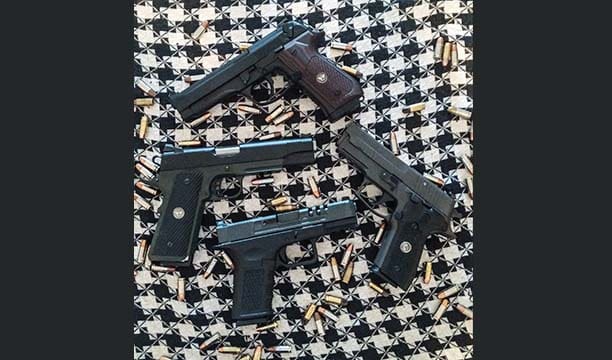
Recently, I decided to put four different quality 9mm pistols through the Bill Wilson 5X5 test. I would have never guessed the results. Maybe I should have. If you’re not familiar, here’s the 5×5 Skill Test protocol which, oddly enough, was designed by Bill Wilson.
Range: 10 yards
Target: standard IDPA target (4” circle head, 7” circle body)
Start position: hands at your sides facing the target. No concealment garment necessary.
Rounds fired: 25The test is intended for a service pistol of 9mm caliber or larger, a concealed carry suitable holster and ammunition with a power factor (bullet weight x velocity) of 125,000 or more. Scoring is standard Vickers with a half second penalty per point down and a full second for any round that misses the target entirely.
There are four strings of fire, each for time:
Draw and fire 5 shots freestyle.
Draw and fire 5 shots strong hand only.
Draw and fire 5 shots freestyle, reload from slidelock and fire 5 more shots freestyle.
Draw and fire 4 shots to the body and 1 shot to the head freestyle.
The winning time: 19:45 shot by…the Wilson Combat Beretta 92FS. No, I didn’t time myself, I had someone else do it right. Yes, I was very surprised.
I’ve never been a huge fan of the 92FS, always considering it acceptable, but not exceptional. I would have guessed it would have come in third in this particular group. Guess I’ll have to rethink that. Of course, it probably also helps that I have over 100,000 rounds through this platform, and the Wilson Combat version pretty much solves all the problems I had with my service model.
Here are the results:
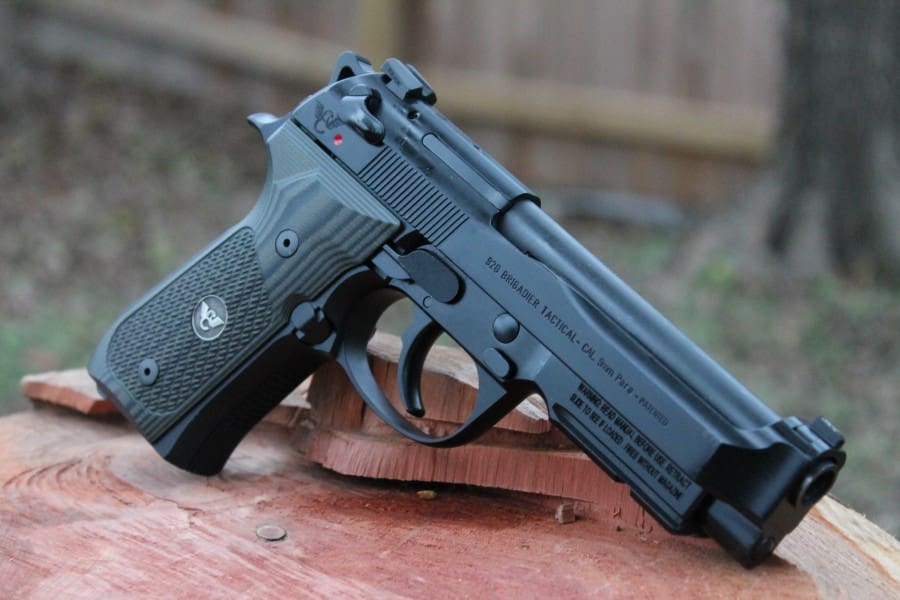
Wilson Combat Beretta 92FS
Total time: 19:45
The real difference: accuracy. This was the only gun that I shot without dropping a point. I shot this gun last in the series, but by the time I was to the test cycle, I was pretty sure this gun would end up first or second. I never had to fight the gun. It felt natural, I was relaxed shooting it, and I could just focus on the sights and the target. That made all the difference.
It should be noted the test gun gun was used as I carried my M9 in combat. Hammer down, safety off, with a round chambered.
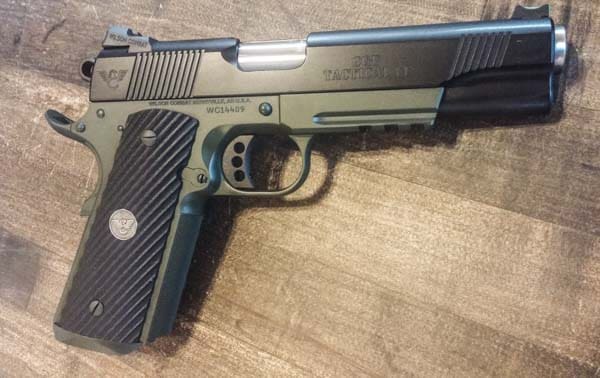
Wilson Combat CQB Tactical LE
Total time: 21:31
The Wilson Combat CQB Tactical LE was actually faster than the 92, but I’m still having a little trouble with my point of aim. When I speed up, I’m often shooting nice tight groups, they’re just too low. This was especially true with single-hand shooting and my first shot out was always the fastest with this gun. I think I’ll swap the sights with a set-up I’m more familiar with, such as Heine Straight 8s. If I can get that sight picture right, this will be the gun to beat.
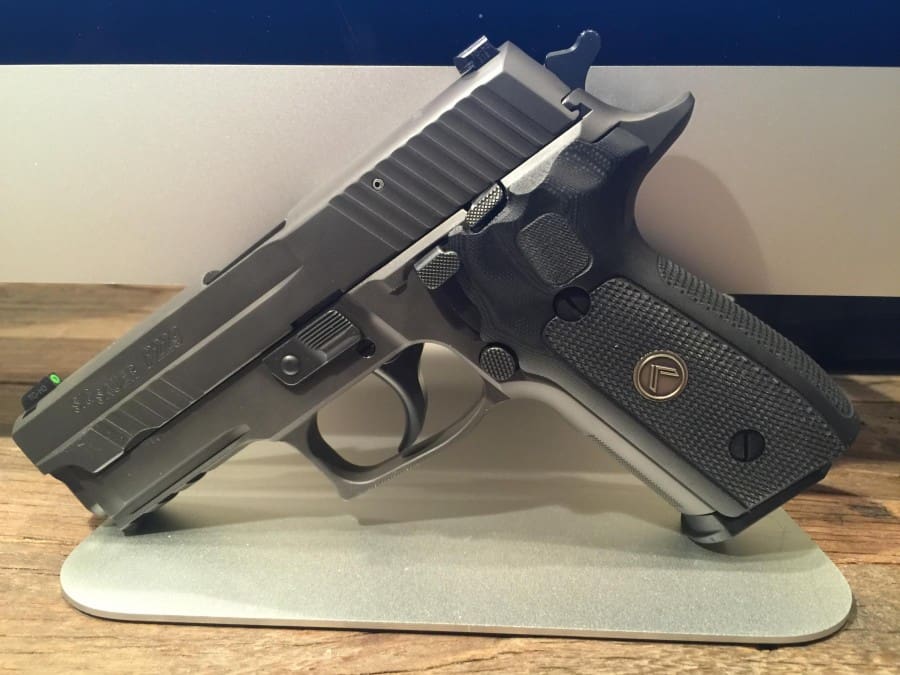
SIG SAUER P229 Legion
Total time: 23:48
If you didn’t show me the time I would have told you the Legion was the winner based on feel alone. The 229 Legion just feels so good to shoot, and that trigger reset is perfect. That makes the gun feel exceptionally fast and it’s every bit as fast as the larger Beretta. I’m just not as accurate with it. I shot the single-hand round without losing a point, but then dropped two during the test cycle. D’oh!
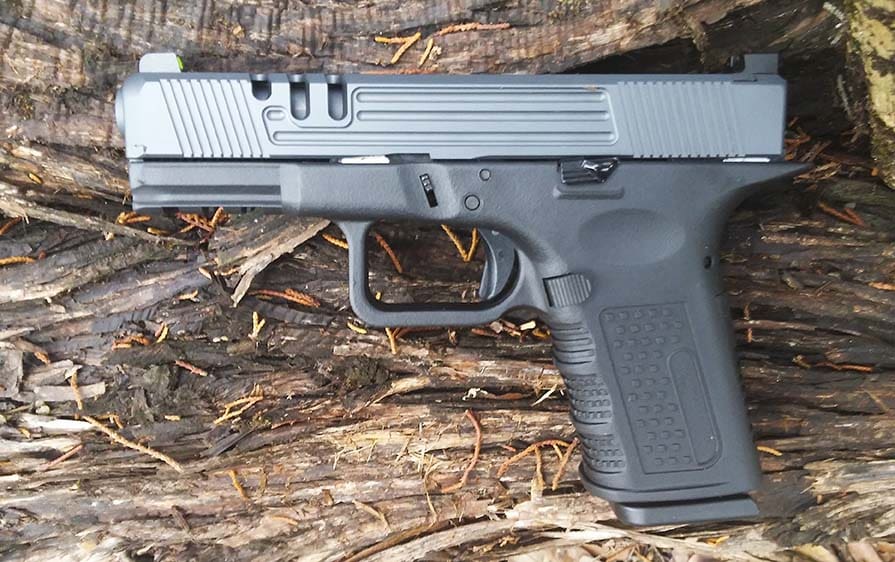
Lone Wolf Distributor’s Compact Timberwolf
Total time: 25:28
One of the very few things left stock on this gun was its trigger, and that was a challenge for me. After my first few absolutely abysmal rounds with this gun, I spent a few range sessions and a week’s worth of dry fire time getting used to it. In those two weeks with the gun, my time came down almost a full class. This particular gun also has a big bright circle front sight. In low light, that sight is awesome. But in the daylight, it’s a little big for me, obliterating the four-inch head circle even at 10 yards. Between the trigger and that front sight, this gun will take a lot more work on my part. Considering all the gun has going for it, that work will be worth the effort.
My methodology was pretty simple. After a familiarization, or refamiliarization, however long that took, I did four practice rounds timed with each pistol. The fifth round was the one I recorded, no matter if it was the fastest or not. No two tests were done on the same day.
Every gun was drawn from an OWB holster made for that gun, without specific retention features. None of the guns were drawn from concealment and I started from the interview position every time. All the tests were shot on the same range, at the same target, using the same Sinterfire Reduced Hazard 90gr Frangible 9mm ammunition which I’ve grown to really like for shooting steel at close range. I’ve been hammering steel targets even at seven yards without any splashback.




Would you care to describe the sight-tracking characteristics of each gun?
Was it consistent or all over the place?
How much vertical and horizontal disturbance was there?
How much effort did it take you to get the front sight back down to the target as/after slide slams home?
Thanks!
Whew, that would be an article in and of itself. The 92fs is much more of a back and forth push, with little rise. The 1911 actually dips a bit, which means I’m driving the gun down, the sig really moves very little, slight figure 8 pattern, and the Timberwolf, which is a much lighter gun, does move up quite a bit more. Not really a fair comparison there.
Of course, these are all 9mms in full size or barely compact pistols. There isn’t much recoil at all.
I see. Thanks a lot!
this doesnt make sense, this is not a gun test but a shooter test.
Every test of pistol or handgun accuracy here at TTAG is exactly that – because no one takes the trouble to use a Ransom Rest.
For two reasons.
1. Setting up a Ransom Rest is witchcraft. I’ve had such mixed results with it that I gave it up.
2. For a shooter, not a manufacturer, it is irrelevant. I don’t care how the gun shoots in a mechanical vice. It is important how it shoots with the human hand and human eye. That human analog interface is paramount. And it’s why I like Mr. Browning’s designs so much.
Exactly! All the bench rest shooting in the world won’t tell you how a gun performs in the hand of a shooter, nor will it prepare a shooter for a real world life and death encounter. And that, after all, is the true test.
What shooting a gun off a bench rest (or out of a Ransom) tells you is “how accurate is this gun?”
Once you’ve determined that, you have an idea how much the variability you see as the shooter is due to you.
I’ll give you an example from my own shooting career. My accuracy in rifle shooting went way up once I purchased an Anschuetz .22LR rifle and I started shooting at 50 ft or 50 yards (winter and summer). Why?
Because when you put the Annie on the bench, and you shoot with match ammo, you come to realize that the rifle is incredibly accurate on and of its own. Therefore, when I’m shooting for group or single shots on targets, if it doesn’t group as well as I know the rifle can group, I’m the problem, not the rifle. Previously, I’d always wondered with my .22’s “How much is me, and how much is the rifle?” – and with a .22 rifle that cannot group any better than about 1.25″ at 50 yards, this is a valid question.
Same deal with my S&W 41. Off the bench at 50 feet, it will use most any sub-sonic .22LR ammo and make groups of about 0.150″ – at the worst. Therefore, when I’m shooting bulleye pistol, if I’m dropping rounds out into the 9 (or further out) ring, that’s my fault, and I need to diagnose and fix my problem.
I’ve seen people obsess for quite a long time about loads in a match-tuned 1911, trying to get groups under 2.5″ at 50 yards. They’d keep wondering what were they doing wrong, etc. They’d keep hunting for a slight improvement in their loads. Well, when we put their pistol in a rest on a bench, guess what? Their pistol groups about 2″ at 50 yards. The human was shooting quite well, in fact. If they wanted to achieve tighter groups, they needed to do something to the pistol as well as the loads.
DG, I get that we are isolating variables. But the human variable is the one that will never leave our shooting, especially with pistols. Do I use a bag? Heck yes I do, and if I’m getting really serious I’ll put all sorts of bags under the slide, under the frame, my hand, forearms, all the way back to my armpits if that’s what it takes to keep it steady. But I still gotta squeeze that trigger without moving the sights. A mechanical rest wont’ do that for me. And that’s key to how the gun performs.
I I think it would be more accurate to say it is a test of shooter / gun combinations.
Not ‘which gun is best’ but ‘with which gun am I best’.
My beef with the M9/Model 92 has never been about the accuracy. It’s always been about the parts count and the overly complex solutions to common firearms design issues in the gun. Oh, and the use of roll pins – which in military or LEO service, are supposed to be replaced every time you detail strip the gun.
How often do you recommend a detail strip for the 92 series pistols? For me, it is extremely rare. Well over 10,000 rounds.
Is it working? Is anything loose? Is there dirt or dust fouling in the mechanism in the slide?
No?
Then I won’t advise messing with it. My criteria on that gun is more one of “how dirty is it?” not “how many rounds do you have through it?” I’d recommend field stripping/cleaning at least every 2500 rounds (if you’re running FMJ NATO type ball ammo) to clean the barrel & slide, but the requirement for a detailed strip is more an issue of how much non-powder fouling is in the lockwork, not how many rounds have run through it.
The 92 is just one of those guns that I really hesitate trying to teach people how to break it down for a detailed strip & clean. It is such a spring bomb, it is one of the few guns where I say “You really need to see a gunsmith or unit armorer.”
Awesome, thank you sir.
The standard Beretta 92/M-9 is both extremely accurate and one of the most reliable pistols on the market. My beef with the Beretta is about me, not the pistol. I cannot shoot the DA pull accurately beyond 5-7 yards. In single action mode I am as accurate with it as I am with a Hi Power. The other issue is frame mounted safety. As a life long 1911 user the safety on all Beretta products goes the wrong way and cannot use it As a carry gun.
The Beretta’s poor reputation comes from military use of old beat up M-9s and cheap magazines. If the military used Glocks, they would have the same reputation.
I second all of this. In addition:
I’ve also heard gripes that when shot by an M-9, the enemy doesn’t die, often enough. But that’s not really a problem with the M-9, but rather having to use 9mm ball ammo.
“the enemy doesn’t die, often enough. ”
The enemy never dies often enough.
Agreed. My wife and I both own a Beretta 92, among many other guns, and we both shoot very well with them. Further, although my wife is actually more accurate with her 1911 Government Model, she prefers to carry the Beretta because of its reliability. She says she knows that it won’t let her down when she needs it.
That is why I eschew the Beretta and have a Taurus PT92 instead. It’s everything you like about the Italian, but with the added benefit of a 1911-style frame mounted safety for cocked-and-locked or a push down onthe same lever for decock. I have no quality issues with this particular Brazillian, seeing as how the PT92 is made on Beretta machinery.
The Beretta 92 is a great gun. All you need to do is practice the first DA pull so you can actually hit something with it and then it’s SA. It’s a much better gun than all the DA only pocket pistols people are buying left and right these days.
You measure the full size WC 92 against a 229 legion instead of a 226 legion with the longer barrel/sight radius. Agree this is not a gun test but a look at which gun I shoot best test.
Besides, he left out CZ.
Cause oddly enough, I don’t own one right now.
“Of course, it probably also helps that I have over 100,000 rounds through this platform…”
The winner of a test like this will be the gun you’re most familiar with.
Today’s winner: Jon Wayne Taylor!
Which is fine, because the Bill Wilson 5×5 test is designed to evaluate shooters, not their tools.
And yet, on his website listing the scores in the Grand Master class, he includes what pistol they are shooting. It’s not the pistol, and it’s not the shooter. It’s the shooter and the pistol. Which is why I was curious to measure how I shot with my “better” 9s. The results surprised me.
You couldn’t find 1 more gun to make it a 5x5x5 test? Come on, man! Get an SP-01 Shadow up in there!
Seriously, no CZ 75, seriously. The second right arm of the free world to the FN FAL.
Send me one.
Buy one. You won’t regret it.
I know, I’ve bought a bunch of them. But when I teach someone to shoot, it’s usually the gun I teach them on, and then I often sell them the gun. I know and love the gun, I just don’t have one right now.
Ha. Nice.
Well, at least you are pushing the brand far more than the LGS’s here. Wish a few more shops carried them in stock…even one CZ dealer I know does not stock them.
About pointing low with a 1911 – that’s why the arched mainspring housing was included in the 1911A1. But fashion is fashion, and it’s flat housings all the way down now.
Agreed. Read up on the design decisions and the progression of the 1911 design over the years and it becomes very clear why they should have an arched mainspring housing.
This brings up a point I like to make about revolvers when someone gives me a lead-in as you’ve just done:
There are many people who have problems “hitting the target” with a revolver, especially large-fisted men using older S&W revolvers with small grips.
When the grip of a revolver doesn’t fill enough of your hand, you will tend to shoot low. When the grip is a bit too large for you, you will tend to “heel” the gun and it will shoot high.
I’m a huge advocate for wheelgun users to get their grips sized so that they can achieve a “natural point of aim” with their revolvers. This might take a bit of custom woodwork to accomplish, but I assure you, it is worth the effort.
Now I have to shoot this exercise to see how I do.
All gun test (practical) are about the shooter/gun combination.
You can have an accurate gun but it may not fare well if it is more difficult for you to run.
A pistol that feels good and runs naturally for you will often provide the best results even if it isn’t the most accurate in a rest.
My 92 is wonderfully accurate but I can shoot my SR9C better in a drill. I also shoot it better than the full size SR9. Not sure why but it feels the most natural.
I can shoot all of them well but the SR9c works best for me. It surprised me the first time I looked the groups and scores.
Interesting ‘shootout’ but I’m afraid it needs a little ah, refinement.
As in a few peeps going head-to-head. The possibilities are many.
You could have had Michal Idan and Kristin Meisner (sp?) in one corner.
Lest the lawyer contingent feel slighted, you could match Ralph up with Dirk Diggler.
2aSux can go at it with Willy Lunchmeat, for the right to face off with the mighty Gersh Kuntzman, he of the super-duper tampon blaster.
Getting my hopes up now, I’m afraid….
Tom 🙂
Kristin shot the drill in about 47 seconds with the 92fs. Don’t think that’s good? It was her third time shooting, and the first time ever shooting that gun. That’s not bad at all. The kid attacks learning and has a great attitude. But dang, there’s not enough coffee in my pot to keep up with her.
If 2Asux is who I think he is then felon and probably pretty good with a gun.
A very enjoyable article. Thanks.
Can’t disagree with the results. I love 1911’s but the Beretta is a great gun.
All non-bench gun tests are about the shooter-gun combination. So, what’s wrong with that? As for the CZ75; a great gun but much improved in the Jericho incarnation. Try it . . . you’ll like it!
“Of course, it probably also helps that I have over 100,000 rounds through this platform…”
I would dare to say that if you had had 100,000 meaningful rounds fired through any decent compact – full size handgun your score would be the best with that particular sidearm over anything else.
The brand does not matter near as much as the fan boys want you to believe it does.
Imagine thinking Glock (or Lone Wolf in this case) is a ‘premium’ pistol.
It’s not even in the same galaxy as Wilson or SIG in any way.
How’s the trigger reach on that Timberwolf frame? I have smaller hands and fingers and have always found my Glocks to be a little too big; I tend to push them slightly low and to the left because I can’t get the pad of my finger on the middle of the trigger face. I’m currently carrying a Sig P320, which I don’t have this problem with, but I still own quite a few Glocks.
When will the myth of low and left/right go away? I’ve heard about every excuse under the sun as to why people shoot low and left/right
1. Wrong Gun Caliber
2. Trigger (Too heavy, Too light)
3. Sights aren’t adjusted correctly
4. Too much trigger finger
5. Not enough trigger finger
6. Grip angle (pretty sure that steering wheel dimensions aren’t a leading cause of swerving while driving a vehicle)
7. John Moses Browning didn’t design ito
8. Shooting out of the wrong eye
9. Wrong Size (Too Big or too small)
10. Action type (SA/DA, SAO, DAO, Striker etc)
11. Sights are too big
12. Target is too small
13. Target is too far away
14. Wrong ammo (i.e. 124 vs. 115gr)
Hours and look in the mirror, that’s your problem.
You suck it’s not the gun.
Thanks for not being very helpful. As stated, with other pistols with shorter trigger reach, I don’t have this problem. If you can’t get your finger on trigger face, you are not going to push it straight back. I’ve spent many hours in front of a mirror. I still haven’t found a way to overcome physics yet. Thank you for your mall wizardry and internet woo. You’ve been as helpful as genital warts.
We shot this cold in a training we hosted. It was pretty humbling for a lot of guys (including some of the instructors).
For fun try it with a revolver or your EDC….
I would like to see the same test with compact 9 mm semi autos designed for concealed carry. Also, vary the range from 3 to 10 yards.
Lone Wolf Timberwolf is considered a premium gun? Huh
Yeah? Taiwanese glock is premium glock?
Comments are closed.